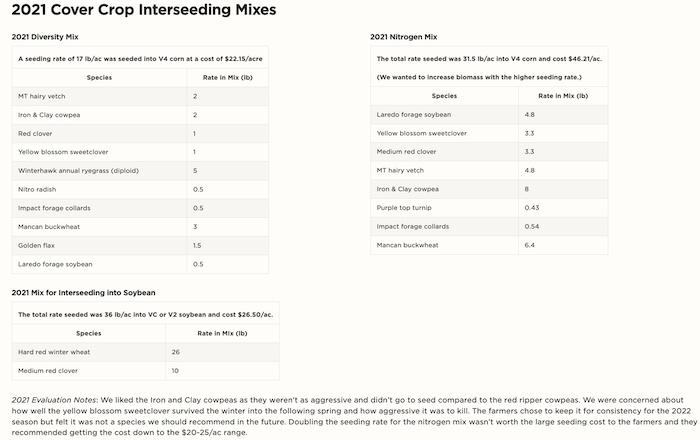- Nebraska On-farm Research Results Interseeding Cover Crops from 2019-2022
- Herbicide Considerations When Interseeding Cover Crops into Early Season Corn and Soybean



Species Selection for Different Goals: Specific species depend on one’s goals. The following suggestions are based off on-farm research observations.
Goal of Weed Control:Cover crop biomass production is key for weed suppression. Buckwheat, cowpeas and forage collards/turnips/radishes are quick to emerge and shade the ground with large leaves.Goal of Erosion Control:Grasses with their fibrous root system can greatly aid in erosion control. However, many cover crop species can help reducing wind/water erosion.Goal of Providing Nitrogen:Cowpeas, other types of beans (mung), hairy vetch, clovers. The clovers and hairy vetch will survive the winter.Goal of Forage:Brassicas such as forage collards/turnips/radishes/rape, annual/Italian ryegrass, clovers. We have had one grower try some sorghum with a lower population of corn (10,000-15,000 seeds/ac) in order to gain more forage. This could also be a consideration in 60-inch rows.Goal of Scavenging Nutrients:Buckwheat scavenges phosphorus. Flax scavenges a number of nutrients. Grasses with fibrous root system will scavenge nitrogen.Goal of Increasing Biodiversity:Buckwheat and Flax are great for pollinators. Flax is one of the best cover crops for increasing microbial biodiversity.Goal of Overwintering:Clovers, annual and Italian ryegrass, cereal rye (need to increase the seeding rate otherwise winter survival is spotty), hairy vetch.If you’re looking for only a few species, we’d recommend annual/Italian ryegrass, red clover and forage collards. Buckwheat is great for corn/corn but will go to seed if you’re in a corn/soy rotation. It will die with soybean POST herbicide, though. Our farmers always added some flax for the biodiversity aspect.Final Thoughts for Success
- Adding cover crops takes more management and a system’s approach. It helps to plan prior to the growing season and it’s important to know one’s goals to determine species.
- Drill interseeding into V3-V4 corn and VC soybean is the development stages we’d recommend.
- May need moisture shortly after interseeding to aid in emergence.
- Herbicide recommendations were shared in this article.




Post a comment
Report Abusive Comment